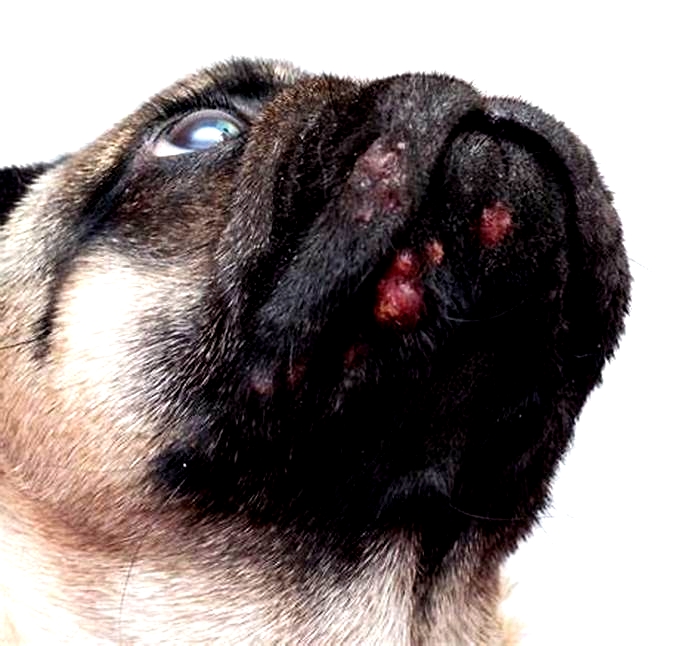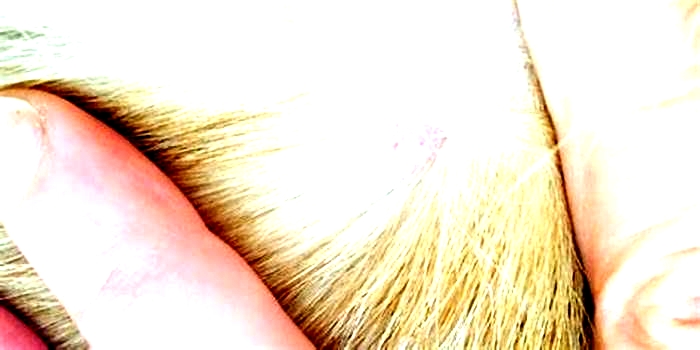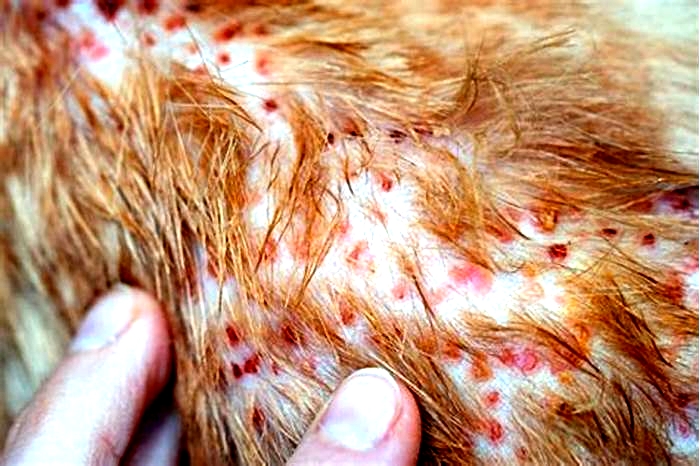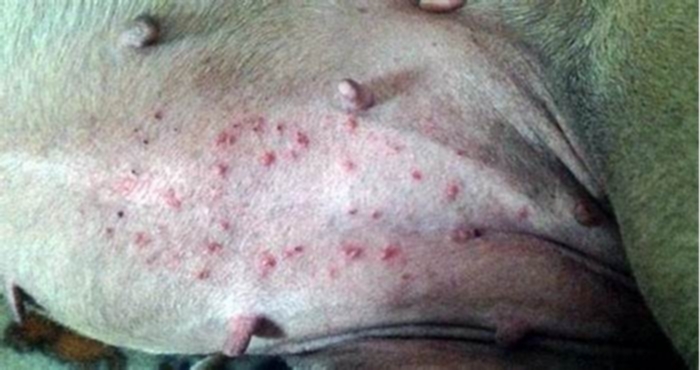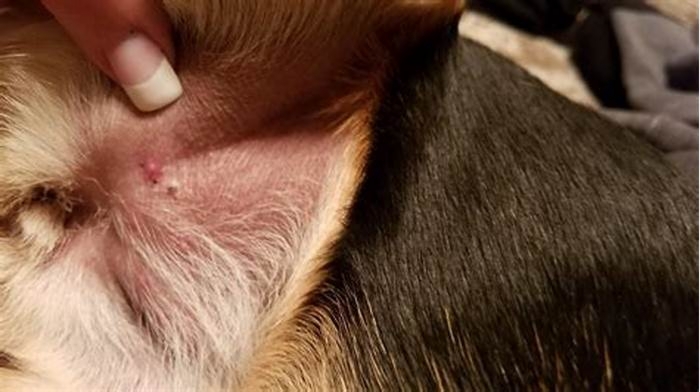What do dog pimples look like
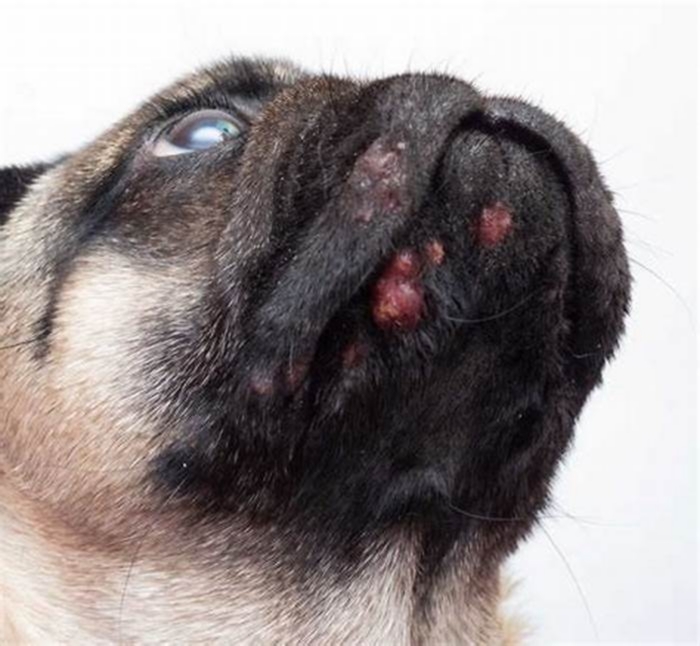
Dog Acne
What Is Dog Acne?
Dog acne is inflammation of the lips and the skin of the muzzle, which can appear as red bumps or pimples on the skin. Acne may begin as folliculitis, which is when short hairs push below the skins surface and become inflamed.
Acne may also occur due to furunculosis, which is when the hair follicle under the skin (also known as muzzle folliculitis and furunculosis) becomes painful, infected, and inflamed, often filled with pus. This occurs when short hairs on the surface of the skin break and are pushed below the skin surface in the follicle.
In both these cases, there is trauma to the tissues, and it can create a chronic condition in which secondary bacterial or fungal infections can complicate the process.
This condition is fairly common in young, short, coated breeds of dogs.
Symptoms of Dog Acne
Dog acne most commonly appears on the bottom of the chin, skin around the mouth, and lower lips. It can look like red bumps, hairless areas, and swelling of the muzzle. As the condition progresses, the bumps can become infected, grow, ooze, or drain fluid.
Causes of Dog Acne
Although the cause of dog acne is often unknown, possible factors include:
Skin damage from rough play or rubbing the face on a rough surface
Itching and rubbing triggered by an underlying skin allergy
Age (most dogs with chin acne are between 6 months and a year old)
Short hair breeds, such as Boxer, Doberman Pinscher, English Bulldog, Great Dane, Weimaraner, English Mastiff, Rottweiler, and German Short Haired Pointer
Dog acne is unique in that typically the only area of the dog affected is the muzzle.
In many cases, the cause of acne is unknown. Some possible causes are localized trauma from rough play or rubbing face on carpet or on rough surfaces. Some pets itch and rub from underlying skin allergies (that affect many parts of the body), and this can complicate or cause the initial acne flare. Not all dogs of the short haired breeds develop chin acne, so its likely genetics and environmental causes play a role in this condition.
How Veterinarians Diagnose Dog Acne
It is important to schedule a visit with your veterinarian if you believe your dog has developed acne and is exhibiting any of the above symptoms.
Your veterinarian will want to rule out other conditions, such as:
Demodicosis: A type of mange that is typically diagnosed through an examine of skin scrapings under a microscope.
Ringworm: In its early stages this fungus resembles acne, so your veterinarian will pluck several hairs for a culture. It typically takes 10 to 14 days to determine whether there is a fungal infection.
Puppy Strangles: A skin disorder that appears in puppies and can resemble acne.
Typically, your veterinarian will do a thorough examination and ask for history regarding diet, treats, supplements, and home environment (your vet may ask about the types of dishes used for pets or whether other pets are in the home). Some pets can have a contact reaction to plastic bowls. Also, it is possible that contamination of bacteria or yeast can hide in micro scratches on plastic dishes.
Your vet may also take skin samples to look for secondary bacteria, yeast, or Demodex mites and possibly order a dermatophyte fungal culture. A bacterial culture may be taken if the acne shows signs of draining to identify the type of bacteria.
In rare cases, a biopsy may be performed to check deep disease, unusual lesions, or cases not responding to therapy.
Treatment of Dog Acne
Treatment of dog acne can include medication, dietary changes, and behavioral therapy.
Your veterinarian may prescribe topical or oral medications to reduce inflammation and fight any bacterial infection, if necessary. Medications can include:
Anti-inflammatories
Antibiotics
Antifungals
Your vet may suggest behavioral therapy to help your dog avoid injuring the area from rough play or rubbing their face on rough surfaces. Your vet may also recommend how to properly clean the infected area to prevent secondary infections.
If your vet finds that your dog has an underlying allergy, they may suggest diet therapy, supplements, and allergy medications (prescription or over-the-counter).
Recovery and Management of Dog Acne
Most dogs with acne recover with proper treatment but do require management, which may include preventing recurring trauma, using topical medications during flare ups, and long-term allergy management if necessary. Some severe cases can result in scarring and can be prone to lesion recurrence.
Dog Acne FAQs
What can I do at home to help my dog's acne?
Behavioral modification to limit contact with rough surfaces or rough play can help limit hair breakage. Keeping the chin area clean and dry can help prevent secondary infections.
Will dog acne go away on its own?
Because the follicle becomes inflamed when the broken hair is pushed deep under the skin, dog chin acne usually requires some form of treatment. The treatment may be mild to significant depending on the individual case. Some dogs with a deep skin infection (pyoderma) may require several months on medications.
Is dog acne contagious?
Most often dog acne is not contagious. If there is a secondary bacterial or fungal infection, the chance of spreading the infection is minimal.
References
Short Jeanmarie DMV.VINcyclopedia of Diseases. Furunculosis/Folliculitis, Muzzle (Canine). Doerr, Katherine DMV. Muzzle Folliculitis and Furunculosis (Chin Acne, Muzzle Acne) in Dogs. Veterinary Partner, 9 June 2020, veterinarypartner.vin.com/default.aspx?pid=19239&catId=102899&id=9707008.
Featured Image: iStock.com/Aladino Gonzalez
Short Jeanmarie DMV.VINcyclopedia of Diseases. Furunculosis/Folliculitis, Muzzle (Canine). Doerr, Katherine DMV. Muzzle Folliculitis and Furunculosis (Chin Acne, Muzzle Acne) in Dogs. Veterinary Partner, 9 June 2020, veterinarypartner.vin.com/default.aspx?pid=19239&catId=102899&id=9707008.
Featured Image: iStock.com/Aladino Gonzalez
WRITTEN BY
Amanda Simonson, DVMVeterinarian
I am a veterinarian passionate about helping animals. I practiced for 15 years in the hospital setting doing medicine, surgery, preventive...
What to know about canine acne and how to treat it
Of course, youll want to try your best to prevent dog acne in the first place. Follow these steps to keep your pups skin healthy, especially if theyre a breed prone to breakouts.
Good hygiene
Just like you exfoliate to keep pores clean and free of excess dirt and oil, dogs can benefit from the same level of care for their skin and coat. Regular baths will keep bacteria, dust, and other irritants at bay. If your dog has flappy skin, be sure to scrub out any dirt that gets trapped under the folds. Dog paw balms can also go a long way in reducing skin discomfort.
Youll also want to practice good doggie dental care. The bacteria that reside in your dogs mouth can make its way onto their chin as they go about their day, setting them up for acne. Brush their teeth regularly to lower the chance of irritation to their muzzle and prevent infection.
Keep them dry
Moisture that builds up when your dogs muzzle gets wet can lead to a bacterial infection. If your best friend drools a lot or is a sloppy drinker, keep a rag handy for wiping their muzzle. Youll also want to thoroughly dry them after a bath, swim, or walk through the rain.
Avoid skin trauma
As mentioned, trauma to the skin can contribute to dog acne. Make sure toys dont have rough edges that could scrape the skin. Investing in glass, ceramic, or steel bowls can also reduce the risk of the adverse reactions some dogs get from plastic bowls, including acne.
If your dog is playing with another dog, be ready to intervene if it gets out of hand and they start biting. Also, look around your pups environment and reduce their exposure to things that could irritate their curious little muzzles.
Stay clean
If your dogs bed or favorite blanket gets dirty, they can develop all kinds of skin issues, including acne. Regularly wash the fabrics they come into contact with daily, like bedding, dog sweaters, and collars. Youll also want to wipe off their toys since theyre going into your pups mouth.
In conclusion, finding a zit, or cluster of zits, on your dog can be jarring, but luckily there is a wide range of treatment methods to get your fur-ever friend the help they need for this skin condition. As long as you take preventative measures and consult your veterinarian when symptoms begin to present, you can ensure your dog is getting the help they need.
Can Dogs Get Pimples? Causes, Treatment & When to Bring to Vet
You share many things with your dog. Ever wonder whether you share too much?
You share your time, your snacks ( can dogs eat pineapple?), and your snuggles. But can you share the flu with your dog? Or viruses?
What about pimples? Does your dog share the same annoying skin issues we humans deal with too? While sharing diseases with your dog is possible, its very rare.
However, dogs can, and do, develop pimples. And theyre sort of the same kind we deal with.
But dont start sharing beauty secrets, pimple remedies, and zit-creams with your BFFbecause lets face it, someone has done it. Instead, read on to find out why dogs get pimples in the first place, what they look like, and why human acne products are not meant for sharing.
Do Dogs Really Get Pimples?
 Yes, dogs can actually get pimples. They can be mild or serious.
Yes, dogs can actually get pimples. They can be mild or serious.
Dog pimples, or canine acne, is an inflammatory disorder resulting in pimples appearing mainly on the lips and on the skin of the muzzle.
Dogs can develop different types of pimples including:
- Pustules
- Papules
- Comedones
Pustules
Small bumps on the skin filled with pus. Usually caused by infection, most commonly staphylococcus, or pyoderma. Pyoderma, sometimes called impetigo, is an infection caused by bacteria. Pyoderma is most commonly seen in puppies.
Papules
Small red, scaly bumps caused by inflamed skin cells. A flea allergy is a common culprit resulting in papules.
Comedones
A comedo is another name for an acne lesion. It forms when a pore, or hair follicle, becomes clogged with debris. More commonly called acne such as whiteheads and blackheads.
Dog acne can range from mild cases of small, red, non-infected pimples on the skin. Or dog acne can be more serious. Severe dog acne is known as generalized acne. When dogs have serious cases of acne you might notice symptoms that include:
- Bleeding
- Scabs
- Swelling around the lips
- Swelling around the muzzle
- Pus
Furthermore, some breeds are more vulnerable to acne breakouts than other breeds. Pimple-prone pooches include:
- Boxers
- English Bulldogs
- Great Danes
- Hairless breeds
- German Short-Haired
- Rottweilers
Whitehead Dog Pimples
Whiteheads are common human acne. Whiteheads are clogged pores, also referred to as closed comedones because the clogs are enclosed by a layer of skin. Whiteheads in humans are essentially pimples that form a white head, essentially the contents of the pimple.
Dogs can get small bumps on their skin that may at first look like whiteheads common to human acne. But what may appear to be several whitehead dog pimples, might actually be sebaceous cysts. Sebaceous cysts are very common in dogs.
Usually, sebaceous cysts arent problematic unless they begin to break open. At that point, theyre also open to potential infections and bacteria getting in it.
Sometimes, sebaceous cyst treatment is necessary and usually, surgery is most effective to get rid of it for good. But, removal isnt always necessary. As they are very slow-growing and can take a long time to reach the point of potential infection. Still, it may be wise to get it checked out by a vet first and then monitor it for any changes.
Why Does My Dog Have Pimples?
 Dog acne can form for a variety of reasons and may or may not involve infection. Acne is a physical change in skin tissue, usually caused by:
Dog acne can form for a variety of reasons and may or may not involve infection. Acne is a physical change in skin tissue, usually caused by:
- Physical injury to the skin
- Disease
The hair follicles inside pores can become irritated quite easily, for instance, when a dog rubs its face on a scratchy surface to get an itch. Microscopic tears in the skin can result after a dog scratches its face using its claws, much like when humans use abrasive skin exfoliates. When there are tears in the skin, the hair follicle can become inflamed, bacteria or debris can enter the skin, and potentially clog pores that lead to dog acne.
Clogged pores are:
- Dead skin cells
- Keratin (a protein found in hair, skin, and nails)
- Sebum (oil)
Essentially, anything that disrupts the skins normal process of moving oil and protein through layers of the skin as per usual, can cause dog acne to form.
Often, pimples go away on their own. But they can also swell and become infected. Pimples that pop, break, or otherwise become enlarged due to the clog are more likely to become infected because bacteria have a way to get in it. While canine acne is considered an inflammatory disorder, dog acne is non-infected. That is, until it becomes infected.
Note that some pimple-like bumps are caused by bacteria, and therefore, are infected. While those bumps may look like acne, their underlying condition is different.
Dog acne can be caused by various factors or underlying conditions. While the causes of dog acne arent entirely clear, experts can agree on several things:
- Dog acne is an inflammatory disorder
- Other bumps may resemble dog acne
- Dog acne mostly appears on the dogs lips and muzzle
- Dog acne inflammation is initially non-infected
Other bumpy skin conditions would need to be ruled out by a veterinarian.
Experts can also agree about several possible reasons why dogs develop acne. While some reasons are less common than others, they include:
- Hormones
- Skin trauma
- Allergies
- Parasites
- Infection
- Genetics
Skin Trauma
This is the most common cause of dog acne. Skin trauma can happen for a number of reasons. When dogs play rough, scratch, or use their muzzle to explore everything in their environment, they increase their risk of damaging the outermost layer of skin and causing inflammation to pores and hair follicles.
Allergies
Dog acne can pop up due to allergies. A dog may rub its face on surfaces to relieve itchiness which can cause the area to become irritated, making it easier for debris, irritants, and bacteria to enter the pores. Types of allergies that can lead to dog acne or breaking out in an acne-like rash are
- Contact
- Environmental
- Food
Like dog flu food allergies are not common in dogs, as only 5% of cases are allergy-related. But when they occur, dogs may experience a host of symptoms that look like dog acne including
- Swelling
- Redness
- Red bumps (hives)
Parasites
Fleas and mites can make dogs itch to the point of breaking the skin and irritating hair follicles leading to dog acne. Moreover, fleas and mites can cause small, red bumps that resemble dog acne.
Oily Skin
Hormone disrupting disorders like Cushings disease or other thyroid-disrupting issues can create hormonal imbalances. Hormonal dysregulation can lead to the skin overproducing oil. Excessive oil production can clog pores resulting in dog acne when it mixes with other pore-clogging debris like dead skin cells and keratin.
Infection
Infections can also lead to dog acne, or acne-like lesions, on a dogs skin. Dog pimple culprits may be:
- Viral
- Fungal
- Bacterial
Bacteria
The most common acne-causing bacteria found in dogs is called Staphylococcus. Bacteria can find their way into pores through inflamed follicles, or through micro-tears on the skin. Pores that are already clogged, in the case of blackheads and whiteheads, for example, can become infected when bacteria enter the pore and become stuck among the clogged debris.
Folliculitis
When short hairs are pushed underneath the skins surface, a condition known as folliculitis can occur. The impacted follicle becomes inflamed and the formation of small bumps that resemble acne can form. But unlike dog acne lesions that may be inflamed but not infected, folliculitis is caused by an infected hair follicle, most commonly due to bacteria.
So, while dog acne and folliculitis may look similar their causes are different. Also, dog acne is usually found on a dogs lips and muzzle. On the other hand, folliculitis can appear anywhere.
Other infections or diseases that can lead to folliculitis:
- Parasites
- systemic disease
- Immune system disorders
- Trauma
- Endocrine problems
Understanding the difference between dog acne (blocked pore) and folliculitis (infected hair follicle) is important for getting dogs the right treatment.
Genetics
Certain breeds are more vulnerable to developing dog acne due to their genes. Short-haired breeds are particularly susceptible because their skin is more exposed, like hairless breeds for instance. Also, short-haired breeds often have coarse fur closer to the skins surface, making it easier for it to become impacted.
Other conditions that can resemble dog acne but may be more serious or contagious, include
- Demodicosis: a type of mange (mites) transmitted from mother to puppy that may resemble whiteheads.
- Ringworm: a type of fungus that resembles acne in its early stages and can be spread from dogs to humans.
- Puppy Strangles: a potentially fatal non-contagious skin condition resembling acne-like blisters and scabs, diagnosed in puppies and young dogs.
Where Canine Acne Can Appear
 Dog Acne is most commonly found around the mouth area, specifically, the chin, lips, and muzzle. A pimple may form as an individual comedo or may appear in clusters. If dog acne becomes infected, the vet may test for the type of bacteria, virus, or parasite causing the infection. Doing so will tell you what type of treatment is needed.
Dog Acne is most commonly found around the mouth area, specifically, the chin, lips, and muzzle. A pimple may form as an individual comedo or may appear in clusters. If dog acne becomes infected, the vet may test for the type of bacteria, virus, or parasite causing the infection. Doing so will tell you what type of treatment is needed.
Dog Acne on Chin
The chin is one of the most common areas for dogs to develop acne. There are several reasons for this.
Muzzle Folliculitis
This is caused when short, coarse hair commonly found on a dogs chin is easily impacted which can cause inflammation and lead to acne.
Muzzle Furunculosis
When the broken or impacted hair causes injury to the hair follicle below the surface of the skin, it can lead to inflammation and infection. Often the infected hair follicle contains pus. When a hair follicle becomes impacted and inflamed, bacteria can find a way in resulting in infected acne lesions.
Dog Pimple on Lip
The lips are a common area for dog acne to form as well. There are several causes for pimples that form on a dogs lips.
Mouth Bacteria
So, are dogs mouths cleaner than humans? Poor dental hygiene is unfortunately common in dogs. Dogs frequently suffer from gum disease, cavities, and oral bacteria. When a dog doesnt receive proper dental care via regular visits to the dentist or daily teeth cleaning, bad bacteria move in. If left untreated, its possible for bacteria to find their way to a dogs lips and mouth and cause dog acne.
Oral Papillomas
Papillomas are warts caused by a virus and are spreadable between dogs. They may look like big pimples located around the mouth and lips. Mostly common among puppies, oral papillomas may not require treatment because they normally go away on their own and typically arent harmful.
Infected Dog Acne
Dog acne can become infected when bacteria enter the clogged pore and get trapped. Infected dog acne results from debris and oil blocking the opening of a hair follicle. An infected dog pimple is called a pustule and is filled with pus and bacteria.
Symptoms of infected dog acne may present with symptoms like
- Swelling
- Redness
- Whiteheads
- Pus
- Bleeding
- Scabbing
Dog Pimples on Back
A pimple on a dogs back can resemble acne but may actually be a sebaceous cyst. A sebaceous cyst is a clogged oil gland that is often much larger than a typical acne pimple. Sebaceous cysts can form when a dogs body is producing too much sebum and causes its pores to become clogged with excess oil. Usually, the cysts arent harmful and treatment may not be needed.
Dog Pimples on Belly
A condition called pyoderma can cause a pimple-like rash to form on a dogs underside. The rash may look a lot like dog acne. Pyoderma may be caused by yeast, bacteria, or fungus and presents with symptoms such as
- Pustules
- Red bumps
- Redness
- Swelling
- Crusty skin
Pimple on Dog Eyelid
A stye on a dogs eyelid can look like a pimple. A stye, also known as a hordeolum, forms on the eyelid and may cause temporary swelling. The culprit that causes a stye to form is a bacteria of the oil gland called Staphylococcus aureus. The swelling is due to the pus inside, but unless the dog scratches the area and causes it to burst, a stye will usually heal on its own.
Pimple on Dog Paw
Dogs can develop a pimple-like abscess on their paw, commonly developing on the webbing between the dogs toes. The lesion is similar to a large, pus-filled pimple and is known as interdigital furuncles. Its similar to folliculitis that can develop on a dogs chin. The primary cause is hair follicles impacting the surrounding skin, causing inflammation. Bacterial infection is then common due to the pore becoming enlarged.
Dog Ear Pimple
Usually, sebaceous cysts can form on a dogs ear and be mistaken for dog acne. Sebaceous cysts may appear anywhere on a dogs body, any size, and may resemble a whitehead. Additionally, small bumps on the outer ear may be due to mites or other parasites that burrow under the surface of the skin, causing bumps to form.
Dog Whisker Pimple
Whiskers are essentially fur follicles except much deeper. And like the rest of a dogs follicles, whisker follicles are susceptible to folliculitis and infection. A dog can develop a pimple on its muzzle that starts as an ingrown whisker.
Find the table below for a quick dog pimple reference guide.
| Dog Pimple Location | Possible Explanation |
| Chin | Muzzle folliculitis or Muzzle furunculosis |
| Lips | Acne lesions or small warts known as oral papillomas |
| Back | A sebaceous cyst |
| Belly | Pyoderma, an infection caused by yeast, bacteria, or fungus. |
| Eyelid | A hordeolum, or stye, caused by bacteria. |
| Paw | Interdigital furuncles, a pus-filled lesion caused by bacteria. |
| Ear | Tiny mites or another parasite that burrows beneath the skins surface. |
| Whiskers | An infected ingrown whisker or folliculitis that has formed a pimple. |
Dog Acne Treatment

 Treatment #1 Anti-Inflammatory
Treatment #1 Anti-Inflammatory
Veterinarians may use an anti-inflammatory to treat dog acne. The most common anti-inflammatory medications include
- Oral steroids
- Topical steroids
Treatment #2 Antibiotics
Antibiotics can be used to treat dog acne when a bacterial infection is present. Antibiotics reduce the number of bacteria that are present on the surface of the skin and within acne lesions. A veterinarian may prescribe
- Topical antibiotics
- Oral antibiotics
Treatment #3 Antifungal
Pyoderma causes lesions on a dogs skin that look a lot like acne. Pyoderma bumps look like small, red bumps on the skin and may be caused by bacteria or fungus. When the condition is caused by a fungus, your veterinarian may prescribe treatment, like
- Antifungal shampoo
- Topical antifungal medication
- Oral antifungal medication
- Oral antibiotics
Dog Acne Home Remedies
 If you feel that your pups particular case of dog zits doesnt warrant a trip to the vet then you might want to know how to treat dog acne at home. There are some at-home dog acne remedies you can try.
If you feel that your pups particular case of dog zits doesnt warrant a trip to the vet then you might want to know how to treat dog acne at home. There are some at-home dog acne remedies you can try.
Hydrogen Peroxide for Dog Acne
Avoid using hydrogen peroxide to treat dog acne. Because dog acne may be considered open wounds, hydrogen peroxide may be harmful to a dogs skin and cause further irritation. Hydrogen peroxide is toxic to dogs and can make them vomit if ingested, even in less-concentrated solutions.
Benzoyl Peroxide for Dog Acne
Benzoyl Peroxide seems to be one of the most common and effective at-home dog acne treatments. Shampoo or face wash containing benzoyl peroxide can effectively clean a dogs pores by removing excess oil and debris. A topical benzoyl peroxide application such as a medicated shampoo or gel may be used once a week to treat dog acne at home.
Use Hypoallergenic Wipes
You can help manage dog acne by keeping their face clean. This is especially important if your particular breed has lots of folds and wrinkles where dirt and bacteria can hide. You can use hypoallergenic wipes daily to help keep your dogs face clean and control dog acne from spreading.
Check out the following table showing how to get rid of dog acne and what to avoid.
| Professional | At-Home | Avoid |
| Anti-inflammatory: Oral or topical steroids like Prednisone or prednisolone. | Benzoyl Peroxide: It seems to be the most common and effective at-home treatment. | Coconut Oil: Coconut oil is comedogenic meaning it clogs pores and may lead to more acne. |
| Anti-fungal: Oral or topical medications like chlorhexidine or ketoconazole. | Hypoallergenic face wipes: Helps to stop the spread of acne and bacteria, especially in wrinkly dogs. | Aloe Vera and Apple Cider Vinegar: While aloe vera may soothe a painful acne lesion, it does not treat dog acne. Apple cider vinegar may irritate open dog acne lesions. |
| Antibiotics: Topical or oral medications may be prescribed, like mupirocin to decrease bacteria count or oral antibiotics for infected cases. Oral antibiotics are usually given for 4-8 weeks. | Daily oral hygiene regimen: Brushing the dogs teeth to keep bacteria from spreading to the lips and chin is helpful for preventing dog acne. | Hydrogen Peroxide: Toxic to dogs if ingested even in small amounts and may cause further irritation to a dogs skin. |
Tips on Preventing Dog Acne
 Dog acne might be inevitable but thankfully not as serious as pneumonia in dogs or kennel cough. Still, there are ways to help your dog from developing more, or more serious, acne. Just follow a few tips.
Dog acne might be inevitable but thankfully not as serious as pneumonia in dogs or kennel cough. Still, there are ways to help your dog from developing more, or more serious, acne. Just follow a few tips.
Resist Popping Dog Acne
Prevention is so easy if only resisting temptation were easy too. While not everyone has made pimple-popping a hobby, some folks just find it fascinating. Nobody can stop you from popping the pimples on your face. But do the dog a favor and resist the urge to pop theirs. Popping your dogs pimples can cause pain, inflammation, and more acne. And nobody wants that.
Oral Hygiene for Dog Acne on Chin
Have you brushed your dogs teeth today? If you havent gotten into the habit yet you might be surprised how much brushing can benefit your dogs oral health. It may prevent acne from forming around the mouth too.
Clean Dog Bowls and Toys
Occasionally cleaning the things your dog puts in its mouth can keep dog acne away. While you cant prevent everything from getting into your dogs mouth, you can do your part in making sure their food bowls and squeaky toys are free from harmful bacteria. Considering bacteria can live longest on surfaces made of plastic or stainless steel, occasionally cleaning dog bowls and chew toys is a good idea.
Acne-causing bacteria is bad enough, now how long does kennel couch live on surfaces?
FAQ

 How to Get Rid of Dog Acne?
How to Get Rid of Dog Acne?
Topical remedies are best. Shampoo, face wash, or topical gels containing benzoyl peroxide are most effective for treating dog acne. Avoid using human acne products on dogs as the active ingredients they contain are too harsh and may be harmful.
What Does Dog Acne Look Like?
Most common on a dogs chin, lips, and muzzle, dog acne usually looks like red or white bumps. Dog zits may be big or small. They may resemble common pimples like whiteheads and contain pus if infected.
Can I Treat Dog Pimples Naturally?
While some claim coconut oil, aloe vera, and apple cider vinegar are effective for treating dog acne, its best to steer clear without first talking to a vet. Coconut oil can clog pores and make acne worse. Aloe vera might be toxic to dogs if ingested and will not clear-up dog acne.
However, it may be used as a topical solution to relieve painful acne spots. Apple cider vinegar, when diluted, may be used to treat acne spots but shouldnt be used on open wounds so its best avoided on broken dog acne.
Conclusion
Even though dog acne is caused by benign material like dead skin cells and excess oil, pores may be more vulnerable to harmful material like bacteria. When this happens, dog acne can become infected. So, while dog acne isnt necessarily serious, it can become a bigger issue if it isnt treated or managed. Use this guide to help you, as some conditions only resemble acne, so its always best to get any strange lump or bump also checked out by a vet.

